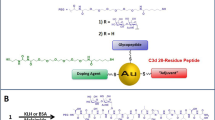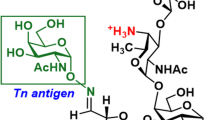Abstract
Background: Nonhuman monoclonal antibodies (MoAbs) of desired specificities have been studied in cancer treatment and tumor targeting with minimal success. Attempts of using humanized chimeric antibodies have not improved significantly their clinical applications. We have engaged in the development of human MoAbs by incorporating the in vitro immunization protocols to the nodal lymphocytes of cancer patients. Three human MoAbs thus generated were found to be strongly reactive with various human malignancies. The antigens recognized by the three antibodies were selected for immunochemical and biochemical characterizations.
Methods: The antigens investigated were AgSK1, PA 1-2 and PA 3-1. The patterns of each antigen expression in various human cancer cell lines were studied by the immunocytochemical staining technique. The expression of AgSK1 in association with cellular proliferation was examined by the flow cytometry analysis. In studying the biochemical natures of these antigens, their sensitivies toward various chemical and physical treatments were determined. The antigens that were shown to be proteins were subjected to SDS-PAGE and Western blot for estimations of molecular weights.
Results: The AgSK1 was detected in 10 human carcinoma cell lines but in none of the melanoma cell lines. This suggests that SK1 may be an epithelial or carcinoma marker. The phenotypic expressions of AgSK1 were shown to be associated with proliferation of carcinoma cells. Biochemically AgSK1 was a sialophycoprotein with an estimated molecular weight of 42–44 kilodaltons (kDa). HuMAb PA1-2 demonstrated a unique staining pattern at both the cytoplasmic and intercellular interface. The stained filamentlike structures extending from cell to cell indicated that Ag PA1-2 might play a role in cellular interactions. Biochemically, Ag PA1-2 appeared to be an asialocarbohydrate. The Ag PA3-1 was a cytoplasmic glycoprotein expressed by all 13 cell lines. The estimated molecular weights of PA3-1 were 164, 104, and 40 kDa.
Conclusions: Tumor-associated antigens recognized by the human MoAbs may be more relevant clinically than those recognized by the mouse immune system. Carcinoma-specific human MoAbs are desirable for cancer treatment and tumor localization.
Similar content being viewed by others
References
Thompson KM. Human monoclonal antibodies.Immunol Today 1988;9:113–7.
Van Kroonenburgh MJPG, Pauwels EKJ. Human immunological response to mouse monoclonal antibodies in the treatment or diagnosis of malignant diseases.Nucl Med Commun 1988;9:919–30.
Koda K, Glassy MC. In vitro immunization for the production of human monoclonal antibody.Hum Antibody Hybridomas 1990;1:15–22.
Ziegler EJ, Fisher CJ, Sprung CL, Straube RC, Sadoff JC, Foulke GE, Wortel CH, et al. Treatment of gram-negative bacteremia and septic shock with HA-1A human monoclonal antibody against endotoxin.N Engl J Med 1991;324:429–36.
Kurtzberg J, Friedman HS, Kinney TR, Chaffee S, Stine K, Falletta JM, Weinhold KJ. Treatment of platelet alloimmunization with intravenous immunoglobulin. Two case reports and review of the literature.Am J Pediatr Hematol Oncol 1987;9:299–301.
Irie RF, Morton DL. Regression of metastatic melanoma by intralesional injection with monoclonal antibody to ganglioside GD2.Proc Natl Acad Sci USA 1986;83:8694–8.
Glassy MC. In:Therapeutic applications of monoclonal antibodies in cancer. New York: Marcel Dekker (in press).
Lloyd KO, Old LJ. Human monoclonal antibodies glycolipids and other carbohydrate antigens: dissection of the humoral immune responses in cancer patients.Cancer Res 1989;49:3445–51.
Yoshikawa K, Furukawa K, Ueda R, Iwasa S, Lloyd KO, Notake K, Takahashi T. A human monoclonal antibodoy recognizing a surface antigen on stomach cancer cells.Jpn J Cancer Res 1989;80:546–53.
Yamaguchi H, Furukawa K, Fortunato SR, Livingston PO, Lloyd KO, Oettegen HF, Old LJ. Cell-surface antigens of melanoma recognized by human monoclonal antibodies.Proc Natl Acad Sci USA 1987;84:2416–20.
Haspel MV, McCabe RP, Pomato N, Janesch NJ, Knowlton JV, Peters LC, Hoover HC Jr, Hanna MG Jr. Generation of tumor-cell reactive human monoclonal antiobody using peripheral blood lymphocytes from actively immunized colorectal carcinoma patient.Cancer Res 1985;45:3951–61.
Cote RJ, Morrissey DM, Houghton AN, Thompson TM, Daly ME, Oettgen HF, Old LJ. Specificity analysis of human monoclonal antibodies reactive with cell surface and intracellular antigens.Proc Natl Acad Sci USA 1986;83:2959–63.
Glassy MC. Immortalization of human lymphocytes from a tumor- involved lymph node.Cancer Res 1987;47:5181–8.
Borup-Christensen P, Erb K, Jensenius JC, Svehag SE, Nielsen B. Human-human hybridomas generated with lymphocytes from patients with colorectal cancer.Cancer Detect Prevent Suppl 1987;1:207–15.
Kan-Mitchell J, White WL, Mitchell MS. Tumor-reactive immunoglobulin G monoclonal antibody from a melanoma patient.Cancer Res 1989;49:4536–41.
Yoshikawa K, Ueda R, Obata Y, Utsumi KR, Notake K, Takahashi T. Human monoclonal antibody reactive to stomach cancer produced by mouse-human hybridoma technique.Jpn J Cancer Res 1986;77:1122–33.
Vollmer HP, O'Connor R, Muller J, Kirchner T, Muller-Hermelink HK. SC-1, a functional human monoclonal antibody against autologous stomach carcinoma cells.Cancer Res 1989;49:2471–6.
Iizasa T, Yamaguchi Y, Tagawa M, Saito H, Fujisawa T, Kato K, Taniguchi M. Establishmnt of human monoclonal antibody recognizing a new-tumor associated antigen from a patient with a small cell lung carcinoma.Hybridoma 1990;9:211–9.
Koda K, Glassy MC, Chang HR. Generation of human monoclonal antibodies against colon cancer.Arch Surg 1990;25:1591–7.
Choi AHC, Siu CH. Filopodia are enriched in a cell cohesion molecule of Mr 80,000 and participate in cell-cell contact formation in Dictyostelium discoideum.J Cell Biol 1989;104:1375–87.
Giulano KA, Taylor DL. Formation, transport, contraction and disassembly of stress fibers in fibroblasts.Cell Motil Cytoskel 1990;16:14–21.
Ockleford CD. Cytoskeletal targets. In: Ockleford CD, ed.An atlas of antigens. New York: Stockton Press, 1989:44–117.
Cooper HS. Peanut lectin-binding sites in large bowel carcinoma.Lab Invest 1982;47:383–90.
Boland CR, Montgomery CK, Kim YS. Alterations in human colonic mucin occuring with cellular differentiation and malignant transformation.Proc Natl Acad Sci USA 1982;79:2051–5.
Chang HR, Koda K, Baird S. AgSK1, a novel carcinoma antigen.Cancer Res 1993;53:1122–7.
Author information
Authors and Affiliations
Rights and permissions
About this article
Cite this article
Chang, H.R., Koda, K., McKnight, M.E. et al. Tumor-associated antigens recognized by human monoclonal antibodies. Annals of Surgical Oncology 1, 213–221 (1994). https://doi.org/10.1007/BF02303526
Received:
Accepted:
Issue Date:
DOI: https://doi.org/10.1007/BF02303526




